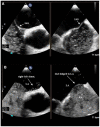Calf muscle pump tensing as a novel maneuver to improve the diagnostic performance of detecting patent foramen ovale during transesophageal echocardiography
- PMID: 36761345
- PMCID: PMC9905729
- DOI: 10.3389/fneur.2023.1116764
Calf muscle pump tensing as a novel maneuver to improve the diagnostic performance of detecting patent foramen ovale during transesophageal echocardiography
Abstract
Objective: The Valsalva maneuver is the most sensitive provocative maneuver for patent foramen ovale detection. However, nearly half of patients are unable to perform the Valsalva maneuver well. The aim of this study was to investigate the mechanism of action of calf muscle pump tensing (TENSE) as a novel patent foramen ovale (PFO) provocative maneuver and to evaluate the diagnostic value for PFO and the effect on right-to-left shunt volume compared with the Valsalva maneuver.
Methods: This study prospectively investigated 171 patients who were highly suspected to have PFO clinically. Five patients with atrial septal defects newly diagnosed on transesophageal echocardiography (TEE) were excluded. 166 patients were injected with agitated saline under three provocative maneuvers: Valsalva maneuver, TENSE, and Valsalva + TENSE combined maneuver. The patients were divided into the effective Valsalva group (n = 93) and ineffective Valsalva group (n = 73) according to whether they could perform an effective Valsalva maneuver. TENSE consisted of the straightening of both lower limbs, and when the right atrium was filled with microbubbles, the patient performed instantaneous ankle dorsiflexion movements while maintaining dorsiflexion for 3-5 s.
Results: Overall, the PFO detection rate of the Valsalva + TENSE combined maneuver (78 [50.1%]) was significantly higher than that of the Valsalva maneuver (51 [30.7%]) and TENSE maneuver (57 [34.3%]) (P < 0.001). In the patients who were able to perform an effective Valsalva maneuver, the PFO detection rate by TENSE was not significantly different from that by the Valsalva maneuver (Valsalva 37/93 [39.8%] vs. TENSE 31/93 [33.3%], P > 0.05), while for the patients who performed an ineffective Valsalva maneuver, the PFO detection rate by the TENSE maneuver was higher than that by the Valsalva maneuver (TENSE 26/73 [35.6%] vs. Valsalva14/73[19.2%], P = 0.017).
Conclusion: TENSE is a simple and effective provocative maneuver in the diagnosis of PFO using TEE and can assist the Valsalva maneuver. For patients who cannot perform an effective Valsalva maneuver, TENSE can be an alternative to the Valsalva maneuver to some extent.
Keywords: Valsalva maneuver; calf muscle pump; patent foramen ovale; provocative maneuver; transesophageal echocardiography.
Copyright © 2023 Zhu, Chen, Zhu, Li, Tang, Huang, Shen, Jiang and Liu.
Conflict of interest statement
The authors declare that the research was conducted in the absence of any commercial or financial relationships that could be construed as a potential conflict of interest.
Figures






Similar articles
-
Inferior Vena Cava Compression as a Novel Maneuver to Detect Patent Foramen Ovale: A Transesophageal Echocardiographic Study.J Am Soc Echocardiogr. 2017 Mar;30(3):292-299. doi: 10.1016/j.echo.2016.11.011. Epub 2016 Dec 23. J Am Soc Echocardiogr. 2017. PMID: 28024853
-
Neglected intrapulmonary arteriovenous anastomoses: A comparative study of pulmonary right-to-left shunts in patients with patent foramen ovale.Front Cardiovasc Med. 2023 Apr 6;10:1111818. doi: 10.3389/fcvm.2023.1111818. eCollection 2023. Front Cardiovasc Med. 2023. PMID: 37089892 Free PMC article.
-
Importance of adequately performed Valsalva maneuver to detect patent foramen ovale during transesophageal echocardiography.J Am Soc Echocardiogr. 2013 Nov;26(11):1337-43. doi: 10.1016/j.echo.2013.07.016. Epub 2013 Aug 28. J Am Soc Echocardiogr. 2013. PMID: 23993693
-
Provocative maneuvers to improve patent foramen ovale detection: A brief review of the literature.Echocardiography. 2019 Apr;36(4):783-786. doi: 10.1111/echo.14297. Epub 2019 Feb 25. Echocardiography. 2019. PMID: 30803022 Review.
-
Transcatheter closure of patent foramen ovale: Current evidence and future perspectives.J Cardiol. 2021 Jan;77(1):3-9. doi: 10.1016/j.jjcc.2020.09.005. Epub 2020 Nov 2. J Cardiol. 2021. PMID: 33144025 Review.
Cited by
-
Comparison of the Application Value of Transthoracic Echocardiography in Diagnosing Patent Foramen Ovale Under Different States of Stimulation: A Retrospective Study.Clin Cardiol. 2024 Aug;47(8):e24319. doi: 10.1002/clc.24319. Clin Cardiol. 2024. PMID: 39109504 Free PMC article.
-
Role of interatrial block in modulating cryptogenic stroke risk in patients with patent foramen ovale: a retrospective study.BMC Neurol. 2024 Sep 14;24(1):345. doi: 10.1186/s12883-024-03829-3. BMC Neurol. 2024. PMID: 39272054 Free PMC article.
References
LinkOut - more resources
Full Text Sources

